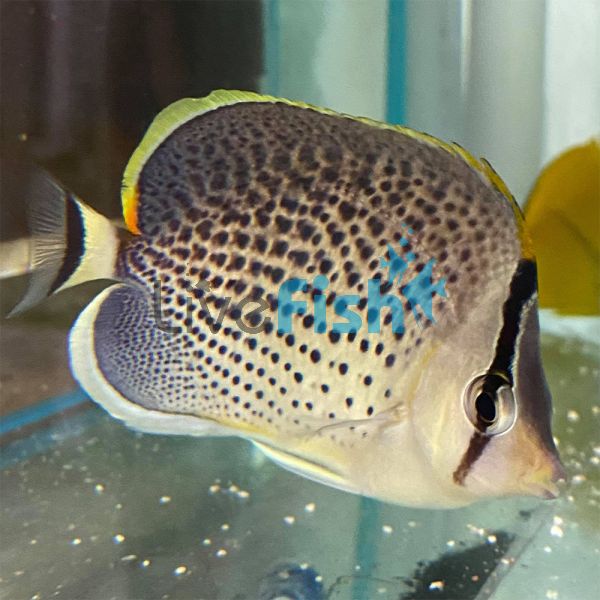Peppered Butterflyfish - Medium
Keeping a Peppered Butterflyfish in your aquarium indicates that you have leveled up your fish husbandry skills. These angelic swimmers are great to watch and are sure to be one of your most prized tank inhabitants.
Peppered Butterflyfish
The Peppered Butterflyfish has a silvery-white base colour with a narrow dark bar through the eye. It also has an orange bar at the back of the dorsal fin and upper caudal peduncle. It has a black submarginal band on the tail, and a yellow margin on the dorsal fin.
They are members of the Exornator subgenus, including the Spot Banded and Sunset Butterflyfish. The dorsal fin's outer edge is yellow. It is not as colourful as some other butterflyfish, but it is an attractive fish. The Peppered butterflyfish is a small butterflyfish that grows to a maximum size of 12 cm.
This species has never been bred in captivity. Butterflyfish are pelagic spawners in the wild, releasing many tiny eggs into the planktonic water column where they float with the currents until hatching. When the fry hatch, they are in a post-larval stage with large bony plates extending from the head.
Peppered Butterflyfish are found from the Red Sea to Durban, South Africa, and east to Christmas Island, western Thailand, and Bali, it can be found also in the Indian Ocean.
Tank Recommendations for Peppered Butterflyfish
This fish is moderately hardy and is recommended for intermediate aquarium keepers. They are one of the family's less sensitive members, and once adjusted, they usually prove to be tough aquarium fish.
These fish need a large amount of space to accommodate their size and to allow them to swim. Because they can grow to be nearly 12cm long, a 300-litre tank is the smallest size we recommend for a single fish. A larger tank is required if you want to keep it in a larger community. An established tank with good algae growth will aid in the acclimatisation of this fish. The tank should be well-decorated, with a rocky environment full of caves and rubble. As this fish eats coral, it is not recommended for reefs.
Frequent water changes are not required; instead, normal water changes of 10% biweekly or 20% monthly are enough.
Suitable Tank Buddies
This species is not generally aggressive but does not get along with other Butterflyfish. It's best to keep a single specimen with other tank mates who are not overly territorial or aggressive.
Usually Compatible
It can be kept with larger, more territorial Angelfishes such as Pomacanthus and Holacanthus. Centropyge and other Angelfish species such as Apolemichthys, Genicanthus, Chaetodontoplus, and Pygoplites may make good tankmates.
Sometime Compatible
Non-aggressive small fishes such as Cardinalfish, Gobies, Tilefish, Fairy Basslets, and Fairy and Flasher Wrasses are normally good tank mates.
Rarely Compatible
Dottybacks, which are small but very territorial, are rarely compatible and should be avoided. Even if they are small, fish like Bass or Scorpionfish should be avoided. Larger Frogfishes can swallow almost anything and should be avoided as well.
Feeding your Peppered Butterflyfish
The most difficult task is getting a new specimen to eat. This could mean putting open mussels and clams in their shells inside the tank or providing some live hard corals. It is said that juveniles and subadults are easier to start feeding than larger adults.
The Peppered Butterflyfish is an omnivorous fish. They eat coral polyps, polychaete worms, and algae in the wild. It is critical to feed a wide variety of live, frozen, and prepared formula foods in the aquarium, with a focus on vegetables and spirulina. These foods can include live brine, flakes, and various frozen foods such as Formula I, Formula II, Angel Formula, and spirulina. Nori from Japan will also be popular. Several frozen sponge-based foods are now available and can be fed to butterflyfish. Feed it at least twice a day, and three to four times a day if it is a tiny juvenile.
| Scientific Name | Chaetodon guttatissimus |
|---|---|
| Care Level | Moderate |
| Common Names | Peppered Butterflyfish, Spotted butterflyfish, Pebbled butterflyfish |
| Diet | Omnivore |
| Fish Family | Chaetodontidae - Chaetodon |
| Lifespan (years) | 4 |
| Max. Length (cm) | 12 |
| Min. Tank Volume (l) | 300 |
| Origin | East Indian Ocean, West Indian Ocean, Indonesia |
| Reef Safe | No |
| Sociability | Peaceful |
| Venomous | No |
| Water Conditions | 72°F - 82 °F (22.2°C – 27.8°C), pH 8.1-8.4 |




